Ryan Hall's Blog, page 236
July 11, 2016
Photos: Breathtaking Highlights from the U.S. Olympic Trials
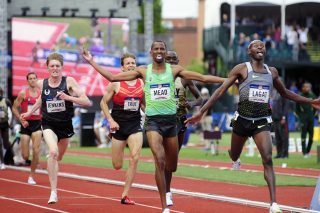
The U.S. Olympic track and field team bound for Rio de Janeiro was determined at the July 1-10 U.S. Olympic Trials in Eugene, Ore. Capacity crowds witnessed record-setting performances, thrilling victories and heart-breaking failures. Some new, young stars arose, but some legendary champions dug deep and finished in one last blaze of glory.
Photo Gallery
1 of {count}
Back to Start
View Larger Image

2016 U.S. Olympic Trials
Molly Huddle proved without a doubt that she's the new American track queen in the distance events. She dominated the 10,000 (31:41.62) on the second day of the meet and then came back to win the 5,000 (15:05.01) on the final day. She says she'll probably only run the 10,000 in Rio, partially because she's also planning on running the New York City Marathon in November. Photo: Dave Albo
View Larger Image

2016 U.S. Olympic Trials
Galen Rupp continued his dominance in the 10,000 (27:55.04), winning his eight consecutive U.S. title and his third Olympic berth in the event. He looked solid in the 5,000 for a bit, but faltered in the last lap and finished ninth. Photo: Brian Metzler
View Larger Image

2016 U.S. Olympic Trials
Allyson Felix was all smiles after winning the 400 in 49.68. But she would later miss the U.S. Olympic team in the 200—the event she won gold in four years ago in the London Olympics—by a mere one-hundredth of a second. Photo: Dave Albo
View Larger Image

2016 U.S. Olympic Trials
As expected, Emma Coburn won the women's steeplechase (in a meet record 9:17.48). Stephanie Garcia tripped over the final barrier, which left Courtney Frerichs and Colleen Quigley uncontested on their way to second and third place, respectively, and their first Olympic berths. Photo: Dave Albo
View Larger Image

2016 U.S. Olympic Trials
Kate Grace was the surprise winner of the women's 800. She ran strong in the prelims and then charged to a new PR of 1:59.10 in the collision-marred final that took out pre-race favorites Brenda Martinez and Alysia Montano. Photo: Dave Albo
View Larger Image

2016 U.S. Olympic Trials
Brianna Rollins won this heat of the 100-meter hurdles and went on to win the finals in 12.34 seconds. Photo: Matt Trappe
View Larger Image

2016 U.S. Olympic Trials
Vashti Cunningham, the daughter of former NFL quarterback Randall Cunningham, placed second in the high jump (6 feet, 5.5 inches) to earn her first Olympic team berth at age 18. Photo: Dave Albo
View Larger Image

2016 U.S. Olympic Trials
Controversial sprinter Justin Gatlin, twice suspended for doping offenses, was nearly unbeatable, winning both the 100 (9.8) and the 200 (19.75) at the age of 34. Photo: Dave Albo
View Larger Image
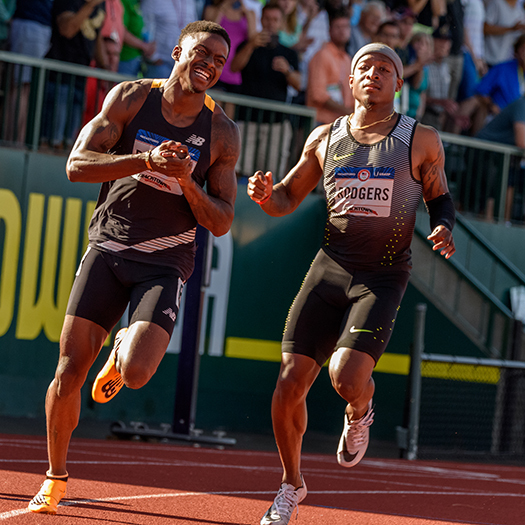
2016 U.S. Olympic Trials
Young sprint phenom Trayvon Bromell placed second in the 100 (9.84) to earn a trip to the Rio Olympics at age 21, while Michael Rodgers, 31, placed fourth, just missing a spot on the team. Photo: Dave Albo
View Larger Image

2016 U.S. Olympic Trials
Oregon's Devon Allen was one of many hometown heroes that the crowds relished. He won the 110-meter hurdles in 13.03. Photo: Dave Albo
View Larger Image

2016 U.S. Olympic Trials
Jenny Simpson looked strong in women's 1500, winning her two prelim heats and then taking the final in 4:04.74. Photo: Dave Albo
View Larger Image

2016 U.S. Olympic Trials
Sydney McLaughlin, a 16-year-old high school standout from New Jersey, placed third in the women's 400-meter hurdles (54.15) to become the youngest American Olympic track competitor since 1972. Photo: Matt Trappe
View Larger Image

2016 U.S. Olympic Trials
Three veterans made the team in the 200—Justin Gatlin (19.75), LaShawn Merritt (19.79) and Ameer Webb (20.00)—but it was the emergence of record-setting high school stars Noah Lyles (fourth, 20.09) and Michael Norman (fifth, 20.14) that had everyone buzzing. Photo: Bob Betancourt
View Larger Image

2016 U.S. Olympic Trials
Perhaps the story of the entire meet was Bernard Lagat's stunning come-from-behind victory in the men's 5,000. The 41-year-old Lagat surged in the final 150 meters to win the race in 13:35.50 and earn a chance to run in his fifth Olympics. The split for his final 400 was an amazing 52.8. Hassan Mead (13:35.70) and Paul Chelimo (13:35.92) placed second and third, repsectively, to earn their first Olympic team berths. Photo: Bob Betancourt

More Galleries
The post Photos: Breathtaking Highlights from the U.S. Olympic Trials appeared first on Competitor.com.
July 10, 2016
Favorites Emerge in Final Day of U.S. Olympic Trials
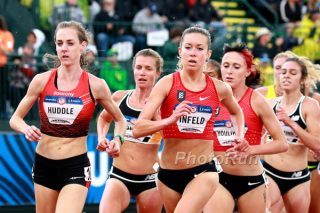
Photo: PhotoRun.net
(c) 2016 Race Results Weekly, all rights reserved. Used with permission.
EUGENE, Ore. — In a memorable final day of the 2016 USA Olympic Trials at Historic Hayward Field, three of the most dominant Americans won in the distance disciplines, putting a firm stamp of success on their quest for the Rio de Janeiro Olympic Games. Matthew Centrowitz sprinted his way to an Olympic Trials record 3:34.09 in the 1500m; Jenny Simpson powered down the stretch to win the women’s 1500m in 4:04.74; and Molly Huddle became the first woman ever to successfully sweep the 10,000m and 5000m at an Olympic Trials, winning the shorter event today in 15:05.01.
Huddle Too Much to Handle in the 5,000m Final
Like she did in the 10,000m on the second day of competition, Molly Huddle took the lead at the gun and didn’t let go in the 5000m. Working with Olympic 10,000m teammate Emily Infeld lap after lap, the pair fronted the charge with the rest of the 14 challengers following close behind. They’d pass 3000m in 9:14.30.
With a kilometer left Huddle finally began to squeeze down the pace, separating from Infeld and causing the field to string out. Shelby Houlihan, Kim Conley, and Abbey D’Agostino did their best to maintain contact.
The ringing of the bell was Huddle’s cue to make the winning move, pumping her arms as the lead went from two to five steps. She’d run a fierce 63.23-second final lap to secure the win, pulling off the first successful women’s 10,000m/5000m double in Trials history.
“It was definitely a wind up. My legs were a little tired from all of the racing this week, so I just wanted to take the kick out of the 1500m girls,” Huddle said. “I just knew I had to make it hurt the last K. As long as I could keep it 70’s and under the last K I knew that would hurt and take the kick out of those girls.”
With Huddle having previously said she’s 99-percent sure she’ll only run the 10,000m at the Olympics, the race was not only for the next three spots, but also a fourth: there was the possibility that Infeld would also give up her 5000m spot in favor of the longer distance.
Nike Bowerman Track Club’s Houlihan was next across the line in 15:06.14, followed by Conley. After losing a shoe and dropping out of the 10,000m –her favored event– Conley rebounded with a strong performance to lock up an appearance at her second straight Olympics.
“I did not want it to come down to a 400 meter race,” Conley said. “It feels great. I feel relieved and triumphant that I was able to pull through for third. It’s been a long eight days.”
Down the stretch, Infeld out-leaned Abbey D’Agostino at the line for fourth, 15:13.87 to 15:14.04. For the second straight Olympic Trials, D’Agostino found herself on the outside looking in by the smallest of margins.
“Just patience. It’s so funny, this is exactly where we were in 2012. A lot of the same players but I was four years younger and a lot more naive. It was such a shock then,” said D’Agostino. “I’m so thankful to have been in the mix given a lot of cross training.” D’Agostino has battled with many injuries over the past two years, though has a knack for performing well in championship races.
Later today came word that Nike Bowerman Track Club coach Jerry Schumacher and Infeld decided to forego the Olympic double, opting just for the 10,000m. The news was first broken by Letsrun.com, and meant that D’Agostino was officially an Olympian.
“It’s outside of my hands, whatever ends up happening,” D’Agostino had said earlier in the day. “I would be so honored to represent the U.S. But if that’s not the case there’s something better in store. I’m just very thankful.”
Defending 5000m national champion Nicole Tully was involved in a fall mid-race and dropped out after 2,600 meters.
The United States athletics team for the Rio Olympics will be announced Monday.
Centrowitz Storms to Victory
Matthew Centrowitz had his father—Matt Centrowitz—in mind going into today’s 1500m. The elder Centrowitz made two Olympic teams back in 1976 and 1980, and the younger Centrowitz wanted to match that accomplishment. But Matthew wanted to go one step further and break Steve Scott’s 3:35.15 Olympic Trials record, too. That’s a time his dad had never eclipsed under any circumstances (his PB was 3:36.70).
“I don’t like to just get the bare minimum,” Centrowitz said. He sports a ‘Like Father, Like Son’ tattoo on his chest. “That [record] was the first thing I thought about… I knew what the Trials record was.”
When Eric Avila and Izaic Yorks took the pace out quick, splitting 700m in 1:42.54, Centrowitz was right where he wanted to be, tucked into fourth. The calm and collected 26-year-old kept an eye on the four other men with the Olympic Qualifying standard in the race. Yet his main purpose was to move into the top three with a lap left.
At the bell, Centrowitz moved up and with 250m remaining opened up his stride to take the lead, as he’s done countless times here at Hayward Field. Around the bend and into the stretch, Centrowitz cemented his cushion and crossed the line with 3:34.09 reading on the clock.
Celebrating the record, he stomped his foot and turned back to the look toward the Hayward Field west grandstand, arms crossed as if proving a point.
While Centrowitz’s win was powerful (his fourth 1500m national title since 2011, and his second at an Olympic Trials), the battle for the final two Olympic spots was pure drama. Ben Blankenship began to fade as Robby Andrews whipped himself into second around the turn. Following Andrews’s lead, Leo Manzano drew even with Blankenship and fought valiantly for the final spot.
A pure 100 meter sprint for glory, it was Blankenship managing to snag third .44 of a second ahead of Manzano, 3:36.18 to 3:36.62. Andrews was a clear second in 3:34.88.
For a good 45 minutes following the race, however, results were unofficial. Multiple yellow flags were raised by officials during the race, and Blankenship appeared to be one of the more aggressive racers from gun to tape. On video he could be seen exchanging elbows with other racers.
While officials looked at the video, Manzano ran cooldown lap after lap alone on the track, joined only by workers taking down the Olympic Trials signage along the stadium’s perimeter. At the same time, Centrowitz, Andrews, and Blankenship sat at a press conference.
“Yeah, it was a bit stressful. But I’m pretty happy to be sitting here,” said a blunt Blankenship
When all was said and done, the results were confirmed with Centrowitz first, Andrews second, and Blankenship third. Manzano, the Olympic silver medalist in London in 2012, will not be competing in his third Games. His streak of finishing in the top-3 at every USA National Championships since 2006 broken.
Centrowitz said he is motivated to improve upon his fourth place finish at the 2012 Olympics.
“God, I feel old saying this but it just seems like yesterday that it was London,” said Centrowitz. “These four years kind of flew by. I wouldn’t say it’s redemption going back trying to get a medal. It’s a different year, different competition, I’m a different athlete than I was four years ago, but I’ll definitely have that fourth place in the back of my mind going into Rio.”
Simpson Looks Smooth in Defense of 1500m Title
Moving into the lead two laps from the tape, Jenny Simpson was poised to make her third consecutive Olympic team. Not wanting to cause a wreck or dash her own hopes for Rio, the 2011 IAAF World Champion pressed the pace and took the bell with two challengers—Morgan Uceny and Shannon Rowbury—off her shoulder.
“In the mind of a competitor, I feel like I went through every possible emotion in this race,” said Simpson. “I was confident, nervous… Once I take the lead I knew I can’t give it up. This is too important, making this team is too important. Getting to the lead was all about if someone wants to make this team they are going to have to take it from me.”
So many podiums this week have been decided in the last 200 meters, and that was just what happened in the women’s 1500m. While Simpson maintained her lead, Uceny surged to second with Alexa Efraimson moving to third in her wake. For a moment it appeared Rowbury and Brenda Martinez had left their kicks too late.
Uceny rounded the final bend in second was fading. Overtaken by a focused Rowbury with 80 meters left, the top two spots were then decided: Simpson ran on to finish first (4:04.74) and Rowbury was a step behind in second (4:05.39).
That left the third and final team spot up for grabs. Brenda Martinez dashed to the inside and took over third place, but had to deal with a fast approaching Amanda Eccleston on the far outside. Martinez ran in lane one, Eccleston in lane three, and both dove for the line at the same instant.
Flat on the ground, neither knew who was third. “I didn’t look up at the board at all. I heard the crowd and they were super, super loud. I had a feeling [a photo-finish] happened,” said Martinez.
It turned out to be Martinez by 3/100ths in third, 4:06.16 to 4:06.19. After getting tripped up in the 800m six days earlier, Martinez had come back for redemption and succeeded.
“I was able to bounce back because of the people, the fans that I have. The nice messages they sent me put me in a good mood instantly and I appreciate all of them,” Martinez said. “Honestly it was just everyone… That fall in the 800 had to happen. To come back and do that, that’s my story.”
Though she was fourth, Eccleston was elated. This is the highest finish of her career at an outdoor championships. She’s gone from a 5:13 high school miler to fourth at the Olympic Trials.
“I gave it everything I had at the end. Every time I had a surge Brenda had another one to match it. I honestly don’t think anyone else other than Brenda had the heart out there at that place to be battling with. After her 800m, I’m happy she made it,” said Eccleston. “Obviously I’m upset not to be going myself but physically I couldn’t have done anything else.”
Simpson will celebrate for one day then focus on leading the charge to Rio. She failed to make it out of the semi-finals at the last Olympics, and now wants her own redemption.
“I’m so excited that I felt so strong through the finish line and then about three steps later I thought another month of hard training,” she told RRW with a laugh. “When you make the Games, what it really means is that this is the first three of six rounds. I’m going to have fun tonight, be excited and celebrate, but I’m going to train tomorrow.”
The post Favorites Emerge in Final Day of U.S. Olympic Trials appeared first on Competitor.com.
July 9, 2016
Bernard Lagat, 41 Years Young, Makes 5th Olympic Team
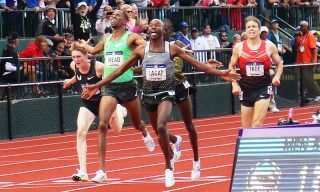
Photo: Chris Lotsbom/Race Results Weekly
(c) 2016 Race Results Weekly, all rights reserved. Used with permission.
EUGENE, Ore. — The first time Bernard Lagat went to the Olympics, the world was getting over the drama of Y2K, George W. Bush was President of the United States, and ‘N Sync topped the music charts with “It’s Gonna Be Me.” Lagat himself wasn’t even an American citizen yet, still representing his home country of Kenya after graduating from Washington State University.
Sixteen years later at the age of 41, Lagat secured a spot at his fifth consecutive Olympic Games by winning the Olympic Trials 5,000m here in a thrilling sprint in 13:35.50, raising the stars and stripes with pride. It took a last lap of 52.82 seconds to give Lagat his eighth national title at the distance.
“I was just telling myself, ‘Keep going, keep going, you can make it, you can do it’ and I kept telling myself that over and over again,” said Lagat, eyes wide with son Miika and daughter Gianna by his side. “When I started passing all the guys I was like, ‘Really it is happening!'”
Joining Lagat on the Olympic team are Nike Oregon Track Club Elite’s Hassan Mead (13:35.70) and the U.S. Army’s Paul Chelimo (13:35.92). Both are first-time Olympians and weren’t yet 10 years old when Lagat made his first Olympic team.
As expected, the race came down to a furious sprint over the final two laps. Yet few anticipated Lagat, a two-time Olympic medalist, could prevail over the likes of younger stars Ryan Hill, Ben True, and Mead. Using the underdog mantra as motivation, Lagat had something to prove in front of 22,847 spectators, the largest audience in Hayward Field history.
The pace went out slow in 75 seconds for 400 meters, a walk in the park for the 16-man field. Portland’s Woody Kincaid and Saucony’s Brian Shrader wound up surging on the fourth lap, dropping an unexpected sub-60-second lap to open a 7-second lead. All of the main contenders stayed patient; they knew that Kincaid and Shrader’s 20-meter lead would shrink at some point, and neither athlete had the Olympic Games qualifying standard of 13:25.00.
The duo led through 3000 meters in 8:25.73 yet were tracked down, and dropped, by Galen Rupp in the subsequent laps. The pride of the Nike Oregon Project held the lead comfortably through 4500 meters.
While the pace had become quicker, all the other favorites were winding up the sprint and anticipating a killer last kilometer.
“I think nobody really wanted to expend themselves and be the one to reel him in because they knew six other guys would be sitting on him,” said Ben True of the strategy to wait and wait and wait some more.
Finally with 450m left the bubble burst and all hell broke loose. Rupp held the lead at the bell by eight steps on Chelimo, Mead, Eric Jenkins and True. Lagat was back in sixth, tucked between the lanky Mead and ahead of Hill.
The pack overtook Rupp down the backstretch; he wouldn’t be a factor in the finish, taking ninth in 13:41.09. Chelimo’s surge to the front was grueling, gaining the pole and gapping Mead, True, Lagat, and company.
Lagat, Chelimo’s elder by 16 years, kept one gear in his pocket coming around the Bowerman Curve and into the homestretch. With 50 meters left, Lagat and Mead went by Chelimo’s right shoulder and crossed the line first, separated only by 2/10ths of a second. Chelimo just held off the final charge by Eric Jenkins, outleaning him by just 6/100ths of a second.
Lagat’s wheels, as old as they may be, had carried him to victory and a fifth Olympiad. It’s all thanks to training under James Li with spry, motivated youngsters.
“I train with young guys, and I don’t believe I am old. If you believe you are old, then I am going to run like an old man,” he said, drawing a laugh from the media. “I am with Sam Chelanga, Stanley Kebenei, all these young guys, Lawi [Lalang] and Stephen Sambu. They push me every single day and you know when I train with them, at the end of the day, they tell me ‘Man you make us really feel bad.’ Because, you know, I don’t give up. I train hard with them and that is what you guys saw today.”
Lagat said he never doubted himself and not once thought he was too old to make it to Rio. DNF’s in the 5000m at the Prefontaine Classic and in the 10,000m here last week were reasons for some to doubt his ability. Lagat said that in both cases he left the track sick to his stomach with disappointment, a feeling that quickly turned to motivation.
“I said I’m not going to end running in Eugene that way. This is Track Town, and I can’t really leave that image with everyone. This is the image I wanted to leave. I was super excited when I won the race,” he said.
Even Mead, who qualified for his first Olympics in second, was blown away by Lagat’s ability.
“I liked my position even with three laps to go, with two laps to go,” Mead began. “I was trying to hold off Lagat a little bit but man! Hats off to him.
“I can’t put it into words man. The man’s inspiring. I thought I was going to win and he came out of nowhere. Trying to hold him off, I couldn’t hold him off. What he is doing is brilliant,” he said. “It’s brilliant for the sport.”
For as much as Lagat’s sprint was inspiring, the heartbreak and despair for top athletes such as Hill and True was devastating. The pair knew their kicks were strong, yet they simply could not find that extra gear when it mattered most. True was fifth in 13:36.40 while Hill was sixth in 13:38.36. Eric Jenkins took fourth by a hair in 13:35.98.
“I’m just really bummed,” said True. “I really thought that I could make the team, I really thought I could do well in the Olympic final. I still think I can run some real good 5000m times and compete on the Diamond League circuit. But it’s just heartbreaking not making the team. It’ll be another four years until I get a shot and that’s a long time. I’m just bummed.”
Hill was equally disappointed.
“I knew there was going to be a lot of shenanigans going on just cause everyone had different motives coming in,” said Hill, the IAAF World Indoor Championships 3000m silver medalist and defending 5000m national champion. “Some wanted it to go slow and some wanted to go fast. Everyone threw their best shot out there and I think I ended up trying to play all of the shots and it kind of wore me out by the end.”
Bernard Lagat’s son, Miika, wasn’t even sure his dad could pull off the win. Watching from a stairwell track-side, he bounced back and forth trying to see what happened on the final lap.
“I was kind of nervous,” Miika told RRW in a quiet voice. “It was kind of crazy. I’m very happy he won.”
The post Bernard Lagat, 41 Years Young, Makes 5th Olympic Team appeared first on Competitor.com.
July 8, 2016
Emma Coburn Wins Steeplechase to Secure Another Olympic Berth
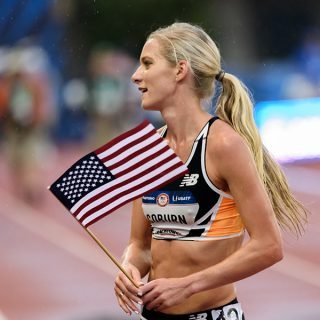
Emma Coburn secured her place in the Rio Olympics by winning the 3,000-meter steeplechase on Thursday night in Eugene, Ore. Photo: Dave Albo
(c) 2016 Race Results Weekly, all rights reserved. Used with permission.
EUGENE, OR (07-Jul) — In every Olympic Trials there is a race that is remembered for its pageantry and magnificence, heartbreak and triumph. In 2008 it was the men’s 800m; in 2012 the women’s 5000m. Tonight, as the rain came down and a brisk wind blew, five women battled valiantly for the right to become 2016 Olympians in the 3000m steeplechase. The drama over the final laps was so intense that even the protagonists couldn’t keep things straight.
“It was such a blur,” said Collen Quigley, one of the women grappling for a spot on the podium.
Quigley would join winner Emma Coburn and runner-up Courtney Frerichs on a soggy victory lap, one that lasted upwards of 30 minutes and prolonged the celebration of a memorable and thrilling race.
Coburn scooted away with the victory, separating from the field in the last kilometer. Yet it was the spectacle behind that mesmerized the 21,835 in attendance.
For a majority of the race, Stephanie Garcia had done the work up front, pushing lap after lap next to Ashley Higginson all the while the field gathered a step behind. Garcia, whose tendency is to run hard in the first half, hung tough through 2000 meters and tucked in for second while Coburn made her drive for the win.
Even with two laps to go, Garcia looked like she had a comfortable cushion on the chasing three: former Michigan State star Leah O’Connor and Nike Bowerman Track Club teammates Quigley and Frerichs.
Sitting in the catbird’s seat ready to pounce, Quigley was first to overtake O’Connor for fourth. Moments later –with roughly 800m to go– Frerichs followed suit and edged past O’Connor. It was at this very point that the race changed drastically.
O’Connor had been dealing with a plantar fascia tear which worsened throughout the race. Upon leaving the stadium, she could be seen on crutches with ice on her foot, holding back tears. Despite pushing through the pain, she’d wind up 14th, and last, in 9:59.03. That, it turned out, was the first heartbreak of the event.
As soon as Frerichs passed O’Connor, she gained a surge of adrenaline. Coupled with the encouraging cheers she heard from coach James Butler at that very moment, she began to open up her stride and reel in not only Quigley (some five meters up), but also Garcia (about ten meters ahead).
“At 800 to go I kind of was in a bit of a darker place. I was like ‘I’m getting dropped and I’m hurting really bad,'” she told RRW. “Once I passed Leah I started getting a little bit of strength and I knew at 400 I could just sense I was really picking up the pace and gaining, gaining, gaining. I just told myself today when I came that I am not getting fourth. My coach [Butler] had told me, too, before the race that if there was a chance in the last 400 that I could potentially be close that I had one of the strongest last 400s. I was channeling that message through my head to get myself close.”
Frerichs’ form was absolutely perfect over the backstretch barrier and following water jump. The former UMKC Kangaroo and New Mexico Lobo drew even with Quigley, a step back of Garcia. Out of the water, the tandem seemed to swallow Garcia whole exiting the Bowerman Curve.
“I just got a burst and I was channeling everything that I had going into the last lap at NCAA’s” Frerichs said, referencing her collegiate record performance of 9:24.41 set here last month. “I just found that place again. It’s a very happy place and it gave me a lot more energy to finish hard.”
Garcia simply had no response. Her once five-second lead had evaporated, and was made worse when she caught her leg on the final barrier, taking a tumble to the ground.
“That’s how it goes,” said Garcia, speaking at length with the media and searching for a positive to take from today. “We have seen at these Trials that there are a lot of amazing athletes who are not Olympians. Hopefully I’m one of them. It’s just time to get down from the emotional cliff and get ready for the summer season.”
The Olympic team was set, with Coburn finishing first in 9:17.48, Frerichs second in 9:20.92, and Quigley third in 9:21.29.
“I think the three of us, and a lot of the girls who didn’t make the team today, have more and more race confidence and our ability as steeplechasers on an international level,” said Coburn, reflecting on the national depth after securing her fifth national title in the last six years. “I think the more and more that we make finals and lower American records and have more and more women under 9:25 or 9:25, I think as a group we lift each other up and feed off of each other’s confidence in the event.”
For all the heartbreak that Garcia felt, it was pure joy for Quigley and Frerichs in particular. Coburn was the favorite and expected to advance to Rio, though Quigley and Frerichs were the two somewhat wildcards. Quigley has dealt with never-ending hamstring and hip injuries since before last year’s IAAF World Championships, and only began hurdling again three weeks ago. Frerichs had to set another PB to snag third in this race, a tough task considering the demanding NCAA schedule.
“That was really tough. I taught myself how to swim this fall because I was running out of cross training options this fall,” Quigley said. “Shalane [Flanagan] texted me this morning and just said when you’re out there today thing of all those hours and literal hours you spent in the pool and on the bike and on the elliptical, and on the Alter-G… That was exactly what helped for me. I was just like I’ve worked so, so hard to do what I love and that’s the running part.”
For close to a half hour the trio stayed on the backstretch and signed autographs for the fans despite the rain and awards ceremony procedures. They had just become Olympians, and nothing else in the world mattered.
“Is this real life?” Quigley could be heard asking Frerichs just before taking the media podium.
Huddle Leads Women’s 5,000 Finalists
Molly Huddle said she enjoyed her 10,000m victory last Saturday for one day before turning her attention to the 5000m prelims. Taking the lead with five laps to go, the Providence, R.I.-based Huddle pushed the pace as assigned by coach Ray Treacy. She’d run her last 1600m in 4:45.10 to take heat-two unpressed in 15:26.33.
“Prelims can be tricky. We don’t do them a lot in the 5000m so I just wanted to make sure I didn’t go too hard out there,” said Huddle. If she was to finish in the top three in Sunday’s final, Huddle said she would likely not double in Rio de Janeiro. The reason not to double is that she’d rather take the two weeks after the Olympic 10,000m to focus on training for her marathon debut at the TCS New York City Marathon rather than the 5000m on the track.
“We are leaning against doing that just because of the marathon in the fall, ’cause I need those two weeks actually to start my buildup. But we’ll talk about that [if it comes up],” she said. “It’s just a hard double at the Olympic level.”
Katie Mackey (15:26.64), Shelby Houlihan (15:26.91), Allie Ostrander (15:27.13), Marielle Hall (15:27.61), and Abbey D’Agostino (15:29.66) rounded out the top six in the heat, by far the fastest of the two sections. This was Ostrander’s first race since suffering a stress fracture at the NCAA Indoor Championships.
Section one went to Kim Conley, who rebounded well after a disappointing 10,000m DNF due to a dislodged shoe. The NorCal Distance Project athlete said she immediately forgot about the 10,000m, using her energy to focus ahead rather than behind.
“It wasn’t that hard for me because it was a decision I made within the race [to drop out and focus on the 5000m],” said Conley, appearing very upbeat after her 15:40.04 win. “It was pretty easy to turn the page at that point and be excited that I get to stay here for the duration of the entire Trials.”
Hoka One One’s Kellyn Taylor (15:40.15), reigning national 5000m champion Nicole Tully (15:40.27), 10,000m Olympian Emily Infeld (15:40.35), and mother of four Sara Hall (15:42.70) finished off the top five.
Not advancing were Laura Thweatt (eighth in section one, 15:50.60) and Gabe Grunewald (11th in 15:58.72). Grunewald would return to run the 1500m in 4:18.07, automatically qualifying for the semi-final.
Favorites Move on in Women’s 1500
Despite knowing only three of the 27 women toeing the line today would be eliminated, Jenny Simpson said all athletes had to respect the process and fight to advance to tomorrow’s semi-finals. Simpson established her position early and led from the gun, ultimately winning heat three in 4:17.31.
“In these rounds, if somebody comes past you, it’s not one person — it’s five people,” said Simpson, the 2011 IAAF World Champion. “That’s what you keep your radar up for. I do remember looking up at the board multiple times to see how the field was doing.”
Behind Simpson, Lauren Johnson and Shannon Rowbury wrapped up the top three in 4:17.53 and 4:17.80, respectively.
The fastest mark of the day went to Amanda Eccleston in 4:13.82. The Michigan alum unexpectedly found herself in the lead early in section one and embraced the feeling. Doing the pacing would turn out a blessing in disguise as she avoided the potentially disastrous collision between Rachel Schneider and Alexa Efraimson at the bell (both Schneider and Efraimson eventually advanced on time).
Brenda Martinez, Morgan Uceny, and Elise Cranny finished three abreast in the second heat, running 4:23.48, 4:23.48, and 4:23.59, respectively. Martinez said she did not dwell on her controversial 800m stumble on Monday, and put the incident behind her as soon as she saw her pet dogs that evening.
Other notable finishers advancing on were high schoolers Christina Aragon and Kate Murphy (fourth and fifth in heat one, 4:14.06 and 4:14.11), as well as Mary Cain (eighth in heat three, 4:19.10).
Men’s 1,500 Semifinals are Stacked
Eight of the 25 men advancing out of Thursday’s men’s 1500m prelim have ties to the University of Oregon. Racing at their college home with little puddles forming on the track, the former –and a few current– Ducks had clear hometown advantage.
“It really feels like a home meet. The rain was a home meet kind of thing, a lot of things I’m used to so far,” said the B.A.A.’s Daniel Winn, who together with former Oregon teammate Johnny Gregorek led most of the first section.
The most prominent Oregon alum, Matthew Centrowitz, didn’t touch the lead and preferred to run from behind. He happened to be next to Nike Oregon Track Club Elite member and fellow Duck alum Andrew Wheating. The crowd responded when Wheating and Centrowitz moved up in the field and ultimately finished third (3:42.41) and fourth (3:42.48), respectively, in heat three.
“It’s just about staying patient, being relaxed and getting through the round as safe as possible,” said Centrowitz. “I definitely looked over my shoulder with about 50 to go and saw I was in the top six and I’m just happy to get through.”
The winners of the heats were Ole Miss Rebel Craig Engels (3:41.92), Ben Blankenship (3:49.61), and Eric Avila (3:42.27). Engels is returning after finishing a surprising fourth in the 800m.
Three of those eliminated were Ford Palmer (who fell during his race and lost contact with the group, timing 3:51.31) as well as former Oklahoma State Cowboy Chad Noelle (3:51.19) and Will Leer (3:54.31).
The post Emma Coburn Wins Steeplechase to Secure Another Olympic Berth appeared first on Competitor.com.
July 7, 2016
Ben True Hoping to Rebound in the 5,000m at the Olympic Trials
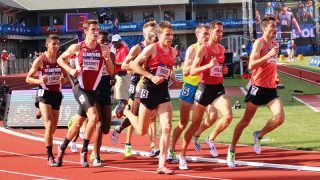
Photo: Chris Lotsbom/Race Results Weekly
(c) 2016 Race Results Weekly, all rights reserved. Used with permission.
EUGENE, Ore. — Once a year Ben True has a race from hell, one that he deems disastrous and forgettable.
In 2015 it came at the USA Cross Country Championships in Boulder, Co., where he was up front before fading to 11th. This year it happened here at the USA Olympic Trials 10,000m. Last Friday, True faded badly due to the oppressive heat and a case of severe dehydration, and finished 11th in 29:04.21 after being in the top six through 6500 meters.
Thankfully, True has already put the race behind him and is focused on the task at hand: finishing in the top three at Saturday’s 5,000m final. Recovered, refreshed, and recharged, True spoke with members of the media after his preliminary heat.
“There’s been a few really terrible races in my career. Boulder XC last year, that was definitely, that one’s up at the top. But Friday topped them all on how terrible I felt and just how out of it I was. I’m just happy to have time now to properly recover,” True said following his third place, 13:48.11 performance in the prelim which safely advanced him to the final.
In the 10,000m, True felt bad during the race, though suffered even more post-race. He spent hours in the medical tent, being checked out by doctors and medical staff. It was the first time he’d ever found himself in the medical tent post-race. With doctors not allowed to replace fluids through an IV (as that is against the rules), True was surrounded by ice and continuously drank as much fluid as possible.
“It just hit me hard. Laying down on the ground I couldn’t get up. I was in the med tent for a couple hours but I’m feeling better now and now I have some time to really recover,” he said.
The 10,000m was a race that wasn’t even worth bringing up with his coach or family, too abysmal to put into words. Yet it served to motivate him going into Monday’s 5000m prelim. Closing with a 54.66-second last lap, True tested his speed and was pleased with the outcome. He felt much better in the 5000m, and showed a glimpse of his 3:36.05-1,500m speed.
“It was good to have a little redemption after the disaster of Friday. Now I have six days of rest,” he said. “We were jogging for most of it so it was nice we were able to close hard. I was able to sit in the second lane the whole time.”
In the final, True is ready for everything. He assumes the pack will keep the tempo more honest than the prelim, wanting to take the sting out of potent kickers like Portland’s Woody Kincaid and Nike Bowerman Track Club’s Ryan Hill (Kincaid closed in 53.72 and Hill in 54.45). Bernard Lagat, even at 41, still has sub-54-second speed in his legs.
For the first time, True’s wife Sarah—a professional triathlete who has already qualified for the Olympic Games—is in town to watch Ben race at a national championships. Flying from Stockholm, Sweden, to Eugene after placing sixth in the ITU World Triathlon Stockholm event, Sarah came to support Ben. She picked him up in her rental car outside of Hayward Field after his prelim, lovingly throwing her arms around his neck and kissing him before they sped away.
“It’s huge,” he said. “It’s great to have her here and support me and, yeah, I definitely would like to compete in Rio as well.”
Considered a favorite for the podium, True has not dwelled on what happened in the 10,000m and has moved on to the 5,000m. Always candid and an outspoken advocate of clean sport, he chalked it up as part of running hard. He’ll be sure it won’t happen in the 5000m.
“That’s just what happens when you train, what happens when you train hard and you’re clean. You have good days and you have really terrible days when you can’t really do much ’cause you just have to allow yourself to recover in between. It’s just impossible to do knockout workouts week after week after week.”
“It was one of those things that was so bad there’s nothing you can read into it,” he said.
The post Ben True Hoping to Rebound in the 5,000m at the Olympic Trials appeared first on Competitor.com.
2017 Boston Marathon Registration Dates Announced
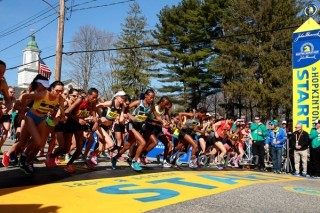
Photo: PhotoRun.net
The B.A.A. has announced its registration schedule for the 2017 Boston Marathon. Like previous years, registration will be done by “rolling admission” with priority given to those who are the fastest qualifiers.
Here’s a quick look at the schedule:
— Monday, September 12: Qualifiers who have met the qualifying standard by 20 minutes or faster can register.
— Wednesday, September 14: Qualifiers who have met the qualifying standard by 10 minutes or faster can register.
— Friday, September 16: Qualifiers who have met the qualifying standard by 5 minutes or faster can register.
— Saturday, September 17: Registration closes at 10 p.m. ET.
— Monday, September 19: All qualifiers who have met the qualifying standard (if space remains) can register. This registration closes at 5 p.m. ET on Wednesday, September 21.
— Monday, September 26: If there are still slots available, registration will open to all qualifiers on a first-come, first-serve basis.
The 2015 and 2016 Boston Marathons had a field size of 30,000 runners, though the size of the 2017 field has not yet been determined. In recent years, there have been more applicants than the alotted field size, and those with faster qualifying times are prioritized. In 2016, runners who were 2:28 faster than their qualifying standard got in. In 2015, it was runners who were 1:02 faster.
Entry fees are $185 for U.S. runners and $250 for international runners.
The 2017 Boston Marathon will take place on April 17.
RELATED: A 10-Step Plan to Qualify for the Boston Marathon
The post 2017 Boston Marathon Registration Dates Announced appeared first on Competitor.com.
July 6, 2016
American Olympic Runner Emma Coburn Bares All for ESPN’s ‘Body Issue’
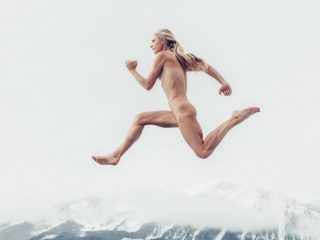
Emma Coburn leaps from a trampoline during a photo shoot in her hometown of Crested Butte, Colo. Photo by Marcus Eriksson for ESPN The Magazine Body Issue
By the evening of July 7, American middle-distance runner Emma Coburn hopes to secure her status a two-time Olympian. If she finishes among the top three in the 3,000-meter steeplechase at the U.S. Olympic Trials, she’ll earn a spot on the U.S. Olympic Team that’s headed to the Rio de Janeiro, where she’ll to be one of the top American medal contenders.
But for now, she’s all the rage because of her inclusion in ESPN The Magazine’s The Body Issue 2016. That’s where athletes in a variety of sports are photographed entirely naked—in a tasteful manner—while mimicking the movements of their sport. (Among the other athletes included in this year’s Body Issue are Denver Broncos linebacker Von Miller, wrestler Adeline Gray, former Olympic diving champion Greg Louganis, fencer Nzingha Prescod and New England Patriots defensive lineman Vince Wilfork.)
Coburn, 25, lives in Boulder, Colo., but the photo shoot was done in Crested Butte, Colo., where she grew up and went to high school.
“I think that The Body Issue is tasteful, beautiful and a once in a lifetime experience for an athlete to be a part of. I’m humbled to be included on the list of athletes who have been in it,” Coburn said.
The issue was released on newsstands on July 6, when the photos also appeared on ESPN.com. It’s interesting timing for Coburn, who will run in the finals of the 3,000 steeplechase at the U.S. Olympic Trials at 7:48 p.m. PT on July 7 in Eugene, Ore. She won her semifinal heat on July 4 in 9:35.28, which is the fastest time heading into the finals.
RELATED: ESPN The Body Issue: Bodies We Want 2016
Coburn is coming off a ninth-place finish at the London Olympics in 2012 and a fifth-place finish at the 2015 IAAF World Championships. Plus, she owns the third-fastest time in the world this year in the 1.86-mile race that involves running 7.5 laps around the track and leaping over 28 barriers and seven water jumps in the process.
A former All-American runner for the University of Colorado, she’s a four-time U.S. champion in the event. She broke the American record on May 28 with a 9:10.76 effort at the Prefontaine Classic in Eugene.
Coburn was the cover runner of Competitor’s August 2015 issue. In that issue, we profiled Coburn’s rise to prominence in the quirkiest event in track.
VIDEO: Emma Coburn Talks about Running the 3,000m Steeplechase
VIDEO: Behind the Scene’s at Emma Coburn’s ESPN Photo Shoot
The post American Olympic Runner Emma Coburn Bares All for ESPN’s ‘Body Issue’ appeared first on Competitor.com.
Running Washington D.C. With Michael Wardian
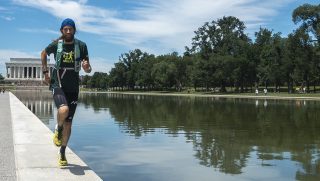
Perhaps influenced by binge addictions to shows like Veep and House of Cards, we started talking recently about how cool it would be to make a return trip to D.C. When visiting family one hour north in Maryland, we jumped at the opportunity to take a running tour of the Capitol with a world-class guide—Arlington, Va., resident and Hoka One One athlete Michael Wardian.
Since 1997 when he completed the JFK 50K, Mike has run 175 marathon and ultra marathon races. His achievements range from a mean marathon PR of 2:17:49 at the 2012 Olympic Trials to completing some of the world’s toughest ultra trail races, like Badwater 100 and Ultra Tour Du Mont Blanc (UTMB).
The above video shows how our day went down.
The post Running Washington D.C. With Michael Wardian appeared first on Competitor.com.
July 5, 2016
Nike AeroSwift Tape—The Next Big Thing in Running?
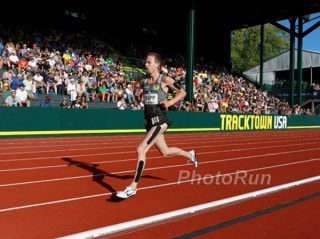
As Galen Rupp was winning the 10,000-meter run on July 1 at the U.S. Olympic Trials in Eugene, Ore., plenty of fans in the grandstands at Hayward Field could be overheard asking things like: “What is that tape he’s wearing on his arms and legs?” and “Is Galen hurt and being taped together with kinesio tape?” Well, Rupp is not hurt, as he proved by winning the 10,000 and also advancing to the final of the 5,000 on July 4. The tape he was wearing was not for injury rehab or prevention, it was all about being more aerodynamic as he ran around the track. Called AeroSwift Tape, it’s part of Nike’s ongoing aerodynamic efficiency research project that also includes the brand’s Vapor track and field racing kits. Click through the photos below to learn more about it.
RELATED: Nike Unveils Innovative Team USA Track Gear
Photo Gallery
1 of {count}
Back to Start
View Larger Image

Nike AeroSwift Technology
Galen Rupp was one of a select few Nike athletes that debuted Nike AeroSwift Tape on his arms and legs during the U.S. Olympic Trials when he stepped on the track for the 10,000. (Eric Jenkins also wore it during the 10,000.) Jorge Carbo, a senior research with Nike's Exploration Team in the Nike Sports Research Lab, says wind tunnel testing has revealed Nike AeroBlade apparel and tape results in a 2-3 percent drop in wind resistance. He says it's impossible to measure how it might play out in a race situation—given variables like wind and an individual runner's form—but the research team is confident it is providing an advantage. Photo: Brian Metzler
View Larger Image

Nike AeroSwift Technology
AeroSwfit technology is also built into Nike's Vapor racing kits. Here Allyson Felix wearing a Nike Vapor track and field kit with tiny AeroBlades on her top, shorts and leg sleeves. As far back as 1996, scientists and aerodynamicists in the Nike Sports Research Lab had theorized that applying textures to a runner could drop aerodynamic drag. It debuted in Sydney in 2000 with the original Nike Swift Suit and continuously evolved the technology, leading to the introduction of nylon flocking, which appeared on the company’s sprint apparel in London 2012. The flocking was effective, but nowhere near as efficient as AeroBlades, which Carbo says elevate Nike AeroSwift technology to a new level. Photo: Caitlyn Pilkington
View Larger Image

Nike AeroSwift Technology
Nike AeroSwift Tape has been in development for three years, Carbo says. Rupp wore it on both arms and legs en route to winning the 10,000 in 27:55.04 to qualify for the Rio Olympics. Photo: PhotoRun.net
View Larger Image

Nike AeroSwift Technology
The small black features on the tape are called AeroBlades and they were designed to create an air vortex—and numerous vortices when positioned together—to create a disturbance in the boundary layer of air going around a runner's body, Carbo says. The tape is applied directly to dry skin after it is rubbed down with an alcohol solution to remove sweat, dirt and oil from eh skin. Photo: Brian Metzler

More Galleries
The post Nike AeroSwift Tape—The Next Big Thing in Running? appeared first on Competitor.com.
Video: Joelle Vaught Sets a New Zion Traverse Fastest Known Time
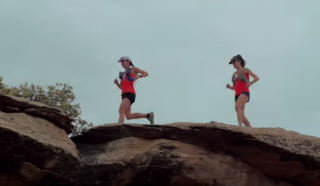
In mid-May, Joelle Vaught set a new Zion Traverse FKT—the “fastest known time” for the 48-mile east to west crossing of Zion National Park—with a big assist from fellow ultrarunner Amy Sproston. Check out this video their experience out on the trails.
RELATED: Inside the FKT (Fastest Known Time) Trend
RELATED: 8 Epic Running Adventures in America’s National Parks
The post Video: Joelle Vaught Sets a New Zion Traverse Fastest Known Time appeared first on Competitor.com.
Ryan Hall's Blog
- Ryan Hall's profile
- 21 followers



